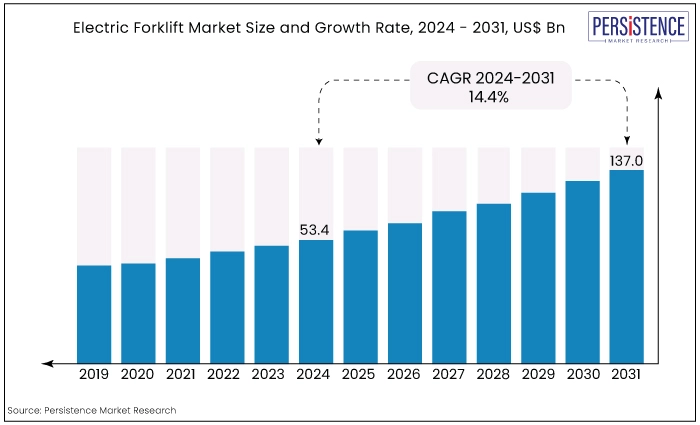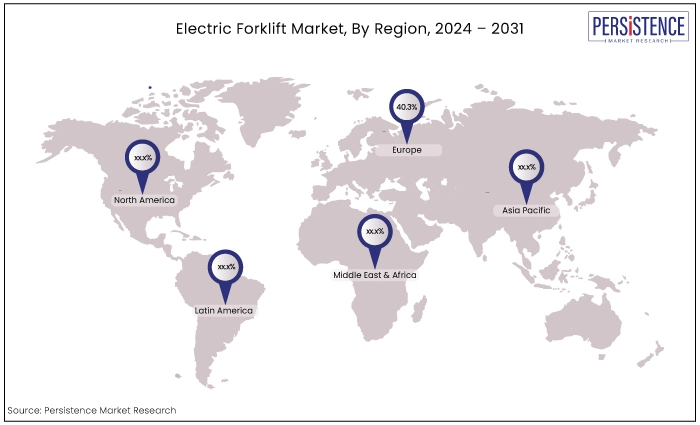Industry: Automotive & Transportation
Published Date: July-2024
Format: PPT*, PDF, EXCEL
Delivery Timelines: Contact Sales
Number of Pages: 182
Report ID: PMRREP34692
The electric forklift market value was estimated at US$53.4 Bn in 2024 and is expected to be valued at US$137.0 Bn by 2031. The market is predicted to achieve an expanding, steady CAGR of 14.4% from 2024 to 2031.
Key Highlights of the Market
|
Attributes |
Key Insights |
|
Market Size (2024E) |
US$53.4 Bn |
|
Projected Market Value (2031F) |
US$137.0 Bn |
|
Forecast Growth Rate (CAGR 2024 to 2031) |
14.4% |
|
Historical Growth Rate (CAGR 2019 to 2023) |
13.2% |
The market has been experiencing steady growth in recent years, driven by various factors such as increasing awareness of environmental sustainability, government regulations promoting cleaner technologies, and the adoption of electric vehicles in various industries.
The market for electric forklifts is expected to witness significant growth in the forecast period, fueled by the implementation of stringent emission norms for diesel vehicles and rising investments in research and development activities.
The market is expected to rise from US$53.4 Bn in 2024 to US$137.0 Bn by 2031, increasing with a robust CAGR of 14.4% during the forecasted period.
One of the market trends is the increasing adoption of sustainable and eco-friendly solutions in various industries, which is augmenting the demand for electric and hybrid forklifts.
Manufacturers are investing in research and development activities to improve the performance and efficiency. Additionally, the implementation of stringent emission norms for diesel vehicles is driving the demand, as they offer cleaner and more environmentally friendly options.
There is a rising demand for operational efficiency in industries such as manufacturing, logistics, and material handling. The increasing number of storage facilities and warehouses is driving the demand, particularly narrow aisle models that can operate in tight spaces and narrow aisles. This trend is also contributing to the market growth.

The market has witnessed significant growth in recent years and is expected to continue its upward trajectory in the future. The market has been driven by various factors, including the increasing popularity of electric forklifts among chemical manufacturers and recycling center owners, the raised demand for operational efficiency, and strict rules for reducing carbon emissions.
According to the market analysis, it is expected to reach US$53.4 Bn in 2024 and is projected to grow at a CAGR of 14.4% from 2024 to 2031.
This growth can be attributed to the rising application of electric equipment across the industrial and manufacturing sectors, paving the way for increased demand for electric material-handling equipment.
The internal combustion engine segment is expected to dominate the market by 2030 due to the increasing popularity of vehicles using gasoline.
Additionally, the integration of electric power trains with internal combustion engines is helping to enhance vehicle fuel economy and further boost electric forklift market sales. The market is expected to reach US$137.0 Bn by 2031.
The market is also influenced by factors such as rapid urbanization and increasing construction activities across the globe, which enhance the demand for forklift trucks.
Furthermore, the production of hydrogen fuel cell forklifts and the development of autonomous forklift trucks offer remarkable growth opportunities for players in the industry.
Environmental Sustainability, and Government Regulations
The growing emphasis on environmental sustainability and government regulations promoting cleaner technologies are driving the demand .
With increasing concerns about carbon emissions and the need to reduce environmental impact, businesses are shifting towards electric forklifts to meet stringent emission norms and reduce their carbon footprint. This trend is expected to continue driving the market growth.
Operational Efficiency, and Cost Savings
Electric forklifts offer operational efficiency and cost savings compared to traditional internal combustion engine models. They have lower maintenance costs, reduced fuel expenses, and longer operational hours due to advancements in battery technology.
Additionally, electric forklifts have quieter operation, which is beneficial in noise-sensitive environments. These market trends are proven to be an attractive choice for businesses looking to optimize their operations and reduce overall costs.
Technological Advancements, and Product Innovations
The electric forklift market is experiencing significant technological advancements and product innovations.
Manufacturers are investing in research and development to enhance the performance, efficiency, and safety features. This includes the development of autonomous capabilities, advanced fleet management systems, and improved battery technology.
Technological advancements are driving the growth of the electric forklift market by providing more efficient and advanced solutions that meet the evolving needs of industries.
Inadequate Training, and Lack of Qualified Workforce
The lack of qualified workers and inadequate training can impede the use of forklifts across various industries. Insufficient training can lead to lower production and increased maintenance costs due to incorrect equipment use. The shortage of skilled operators may restrict the adoption of forklifts, hindering the electric forklift market expansion.
Initial Cost, and Accessibility
The initial cost is generally higher compared to conventional internal combustion engine models. This cost difference can make forklifts inaccessible to small and medium-sized companies with budget constraints. The higher upfront investment required for forklifts can be a barrier to entry for some businesses, limiting market growth.
Developing Markets, and Industrialization
The rapid industrialization and urbanization in emerging markets present significant opportunities for the market demand. As these economies continue to grow, there will be an increased demand for material-handling equipment, including electric forklifts.
The shift towards cleaner technologies and the need for efficient and eco-friendly solutions will drive the adoption in these markets, creating growth opportunities for manufacturers and suppliers.
Advancements in Battery Technology
Continuous advancements in battery technology offer a promising opportunity for the market growth. The development of high-performance batteries with longer operational hours and faster charging capabilities will enhance the productivity and efficiency.
With improved battery technology, electric forklifts can operate for extended periods without the need for frequent recharging, leading to increased uptime and reduced downtime.
Pallet Trucks Drive Maximum Market Demand with Novel Features
|
Category |
Market Share in 2023 |
|
Product - Pallet Trucks |
28.4% |
In 2023, the pallet trucks segment held a dominant position with a 28.4% share of global electric forklift market revenue. This segment is fueled by strong demand from end-use industries and a wide range of products that can handle various loads.
Electric pallet truck forklifts offer efficiency and user-friendliness, leading to increased productivity in material handling. As a result, they are increasingly utilized in logistics and warehouses for efficient item handling.
Meanwhile, the reach truck segment is expected to experience significant growth from 2024 to 2030. Reach trucks are well-suited for maneuvering in narrow aisles due to their wheel placement directly under the operator, allowing for tight turns.
Lithium-ion Battery Leads the Market on the Back of Battery Technology Advancements
|
Category |
Market Share in 2023 |
|
Battery Type – Li-ion Battery |
21.9% |
The Lithium-ion battery segment is projected to grow at a 21.9% CAGR from 2023 to 2030 due to its popularity and advantages over conventional battery technology, including durability, fast charging, and lightweight. Despite this growth, the electric forklift market shares are still dominated by lead-acid batteries due to their lower cost.
Many businesses opt for lead-acid batteries as they offer a cost-effective solution for material handling operations, although increasing investment in R&D activities continues to drive the adoption of lithium-ion batteries in the market.
Industrial Sector Registers Highest Adoption
In 2023, the industrial segment held a prominent position in the market. The growth of manufacturing across various industries, fueled by economic expansion and increased disposable income, is expected to drive the growth of the industrial segment.
The use of robotics and automation in the industrial sector has led to a higher demand for electric forklifts. These machines have the potential to enhance operational efficiency.
With advantages such as lower operating costs, reduced maintenance, quieter operation, and zero emissions, electric forklifts are becoming increasingly popular in diverse industrial applications.
|
Region |
Market Share 2023 |
|
Europe |
40.3% |
Europe Retains Primacy, Demand Robust in Automotive and Electronics Industries
Europe's electric forklift market took the lead in 2023, capturing a significant 40.3% share of global revenue. The region is witnessing a surge in demand for electric forklifts, driven by its flourishing automotive and electronics industries.
As a prominent manufacturing hub for major automotive and consumer electronics OEMs, Europe is expected to see a continued increase in the demand for forklifts within the region.
Asia Pacific Gains from Plant Automation, and Operational Efficiency
The Asia Pacific market is poised to experience the fastest CAGR of 15.9% from 2024 to 2031 in the electric forklift market. The region's manufacturers are increasingly adopting plant automation, which is fueling market growth.
Forklifts play a vital role in enhancing operational efficiency and streamlining production processes by facilitating supply chain distribution activities. Several regional players are focusing on introducing new products as a key strategy to attract new customers and expand their customer base.
North American Picks Pace in Line with Growing Focus on Environmental Sustainability
North American market is expected to experience significant growth from 2024 to 2031. Electric forklifts are gaining popularity in the region due to their lower operating costs, environmental sustainability, and advancements in battery technology.
The US is projected to grow at a CAGR of 12.2% during this period, driven by advancements in battery technology and growth in industries like retail, and e-commerce.
Canada is expected to have the fastest CAGR, supported by government initiatives for environmental sustainability and the development of charging infrastructure.

Companies operating in the electric forklift market are actively seeking growth opportunities through acquisitions and promoting innovation. The competitive landscape is being enriched by the emergence of startups that offer distinctive solutions.
To maintain a competitive edge, companies are making significant investments to expand their production capabilities and enhance technological features. Their goal is to develop innovative functionalities and seamlessly incorporate technologies into this rapidly evolving sector, facilitating successful market entry and widespread adoption.
Recent Developments
March 2024
Komatsu has unveiled a concept machine for an electric forklift powered by sodium-ion batteries, set to start PoC tests at customer worksites. This marks Komatsu's first venture into equipping machines with sodium-ion batteries, a pioneering effort in the world.
The sodium-ion batteries, despite their lower energy density, support rapid charging, enabling continuous operation through frequent recharges. The concept machine is designed for Komatsu's 1.5-ton class electric forklifts and aims to accelerate electrification of all types of worksites, reducing environmental impacts and achieving carbon neutrality.
June 2024
Konecranes has introduced a heavy-duty version of its flagship E-VER electric forklift for lifting capacities of 18-25 tonnes. The 18-to-25-tonne model is designed for heavy-duty industrial applications, with low energy consumption and zero tailpipe emissions. It features a lithium-ion battery pack that fuels the electric motors, allowing fast charging in under an hour during busy work shifts and slower charging when not in use.
The truck can use up to 90% of available energy and can be repurposed as a power reserve at charging stations or a backup power supply if regular sources fail. The truck is equipped with safety features, including a battery management system, thermal management system, and a protective frame.
|
Attributes |
Details |
|
Forecast Period |
2024 to 2031 |
|
Historical Data Available for |
2019 to 2023 |
|
Market Analysis |
US$ Billion for Value |
|
Key Country Covered |
|
|
Key Market Segments Covered |
|
|
Key Companies Profiled |
|
|
Report Coverage |
|
|
Customization & Pricing |
Available upon request |
By Product
By Battery Type
By End Use
By Regions
To know more about delivery timeline for this report Contact Sales

The market for blister packaging is anticipated to grow from US$53.4 Bn in 2024 to US$137.0 Bn by 2031.
Increasing environmental sustainability awareness, government regulations, and the adoption of electric vehicles are boosting the market growth.
Anhui Heli Co., Ltd., Clark Material Handing Company, Hangcha Forklift, Hyster-Yale Materials Handling, Inc., and Jungheinrich AG are some examples of key industry players.
Challenges like lack of qualified workers, inadequate training, and the high initial cost of electric forklifts are restraining market expansion.
Rapid industrialization urbanization, and advancements in battery technology are the key opportunities in the market.